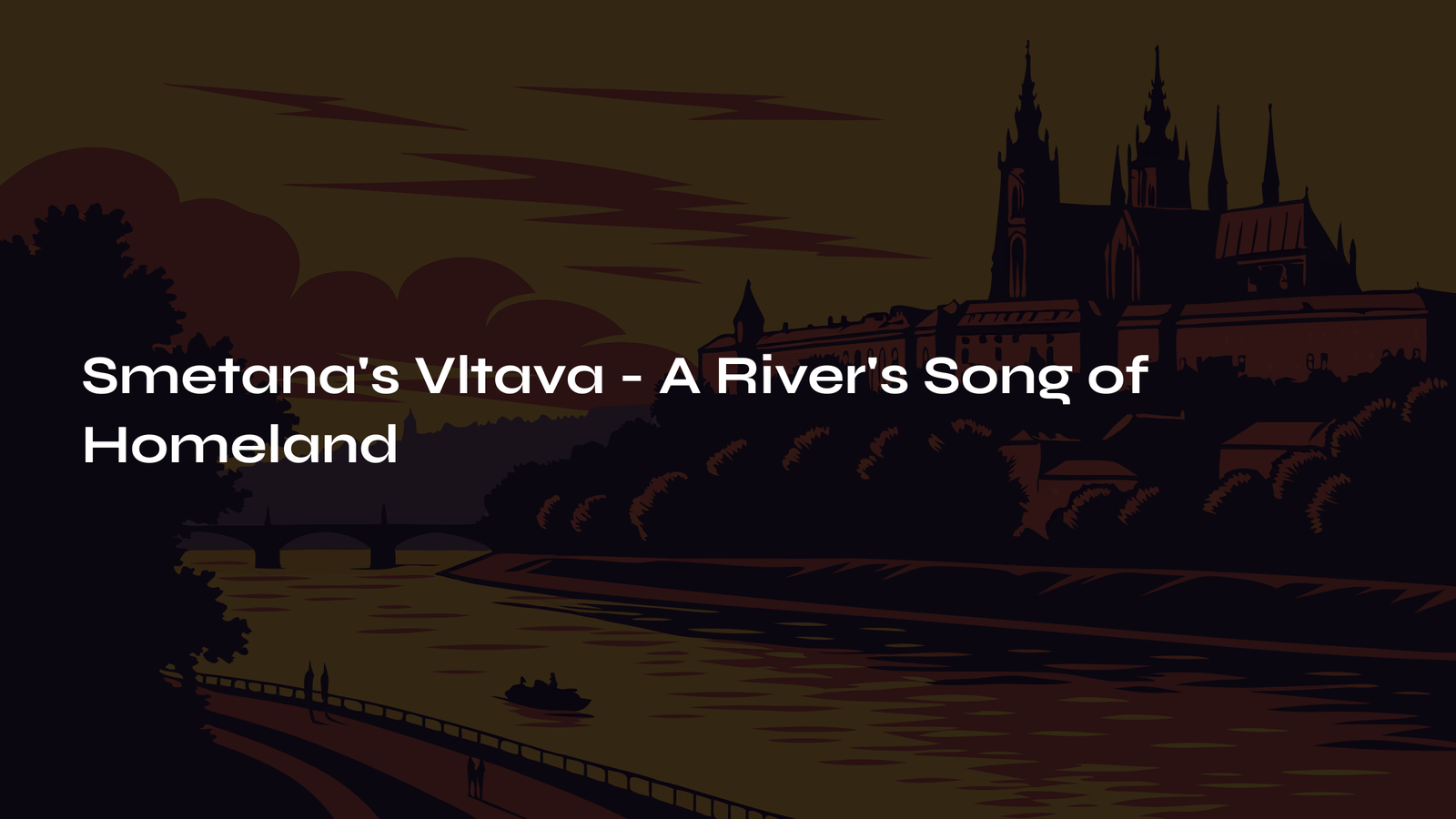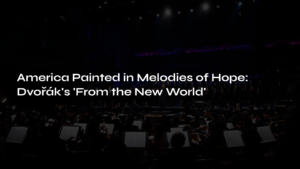Table of Contents
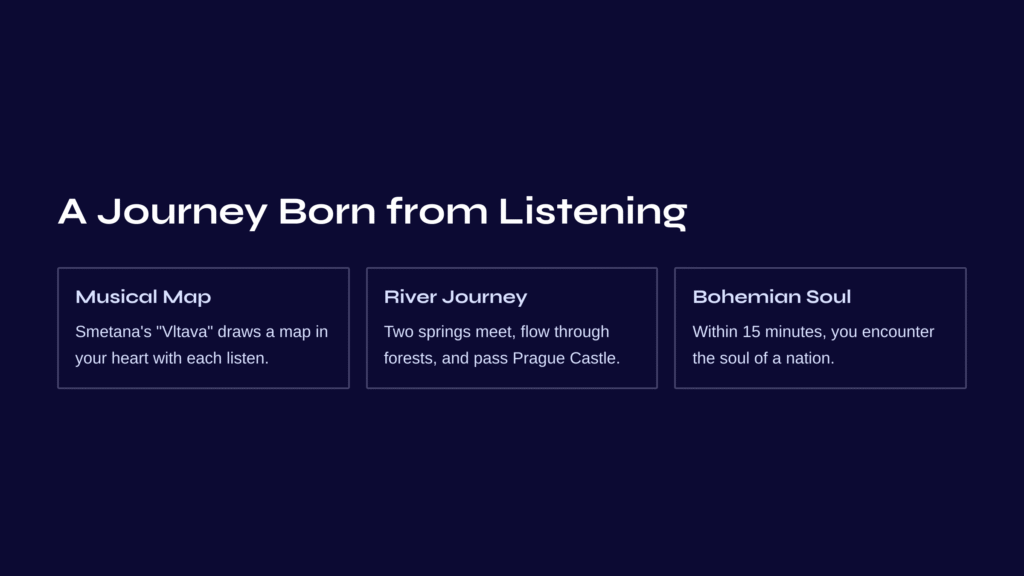
A Journey Born from Listening with Closed Eyes
Some music draws a map in your heart every time you listen. Smetana’s “Vltava” is precisely such a piece. From the very first hearing, I found myself mysteriously traveling along a Czech river I had never seen. The sound of two small springs meeting to become one river, the string waves sparkling like ripples while passing through forests, and finally the majestic flow past Prague Castle’s grandeur.
When I listen to Vltava, I become a traveler. No, I become the river itself. Within this 15-minute musical journey with its clear beginning and end, I encounter the soul of a nation called Bohemia.
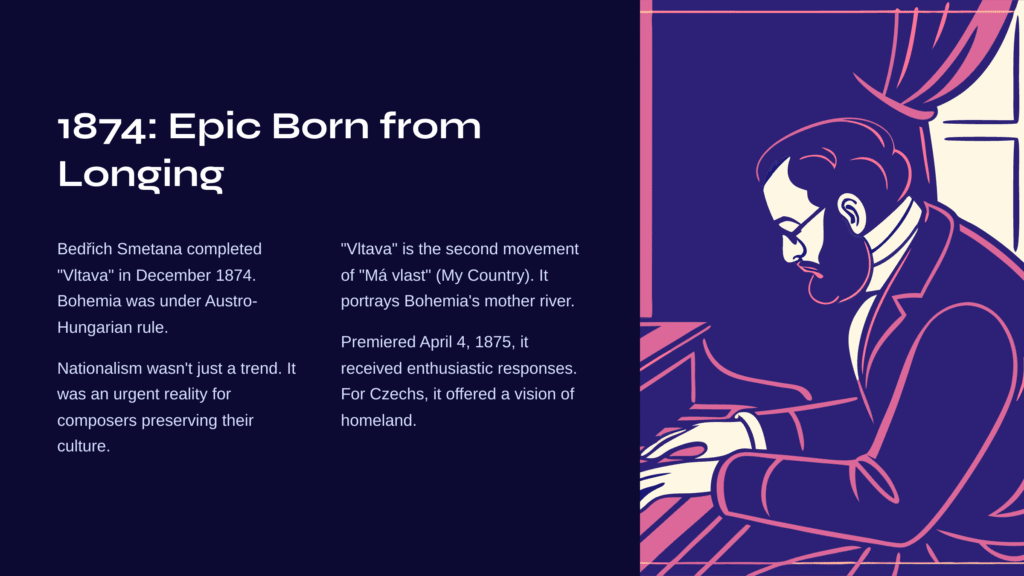
1874: An Epic Born from Longing for the Homeland
Bedřich Smetana completed this composition in December 1874. At that time, Bohemia was under Austro-Hungarian rule, and for composers who desperately wanted to preserve their culture and identity through music, nationalism was not merely a trend but an urgent reality. Smetana composed Vltava as the second movement of his symphonic poem cycle “Má vlast” (My Country), creating a grand epic that portrayed Bohemia’s mother river in music.
The symphonic poem genre itself was a product of 19th-century Romanticism. Unlike purely abstract symphonies, symphonic poems depict specific stories, landscapes, and emotions through music. Vltava represents the most perfect example of “pictorial music” within this tradition.
Premiered on April 4, 1875, under Adolf Čech’s baton, this piece received enthusiastic responses from its very first performance. For Czechs, it offered a vision of their lost homeland; for foreigners, it presented the beautiful landscapes of Bohemia.
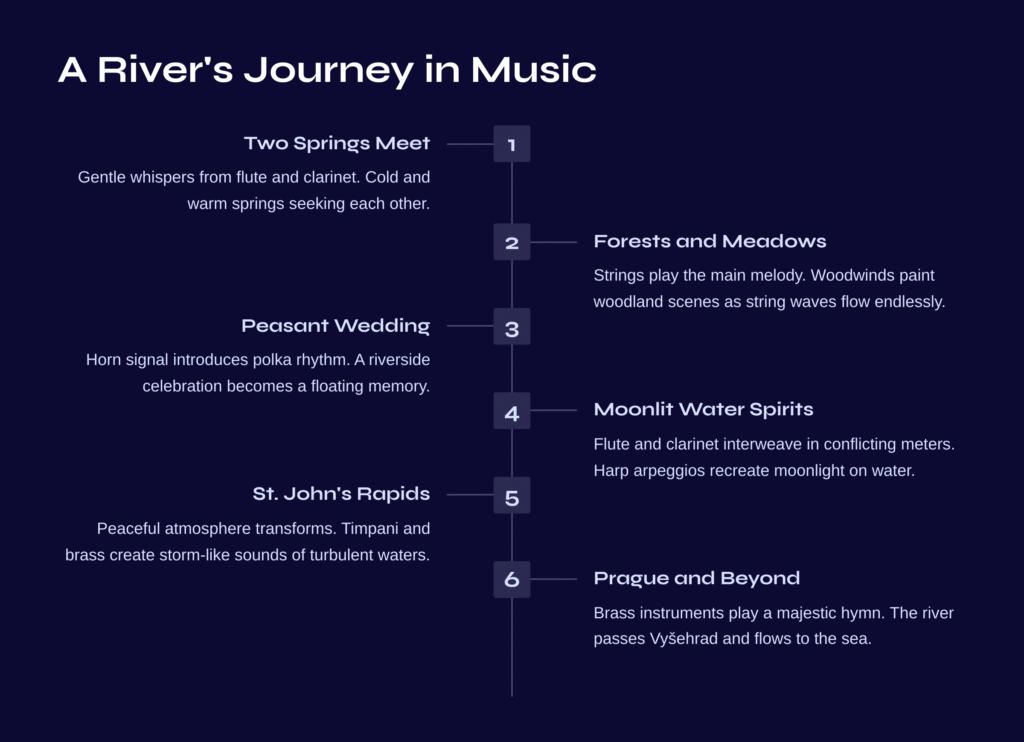
From Two Springs to the Ocean: A River’s Journey in Music
The Birth of Life: The Moment Two Springs Meet
The piece begins with gentle whispers from flute and clarinet. It’s as if cold and warm springs, emerging from deep underground, are seeking each other as they flow. Whenever I hear this section, I imagine the miraculous moment when tiny water droplets gather to create a single stream. The continuously moving 16th-note patterns seem to capture the very essence of water’s whispers.
Forests and Meadows: River Waters Flowing Through Nature’s Embrace
After the two springs merge, strings begin to play the main melody softly. This is Vltava’s representative theme. Interestingly, this melody originates from the Italian Renaissance piece “La Mantovana,” but through Smetana’s hands, it acquired a completely Slavic character. Above the woodland melodies painted by woodwinds, string waves flow endlessly. Listening to this section conveys the tranquility of river waters passing through Bohemia’s deep forests.
Peasant Wedding: Life’s Joy Reflected on Water
Suddenly, a horn signal introduces a polka rhythm. This depicts a peasant wedding celebration by the riverside. Here, the music momentarily transforms into a festival. While polka is Bohemia’s representative folk dance, in this context it sounds like a memory floating on the river’s flow. The footsteps of dancers, laughter, and joyful celebrations all meld into the music.
Water Spirits Under Moonlight: Mystical Night Dances
This is the most fantastical section. Flute and clarinet interweave, playing in conflicting duple and triple meters, depicting water spirits dancing under moonlight. Listening to this passage creates an illusion that time has stopped. On the boundary between reality and fantasy, mysterious beings seem to appear on the shimmering water surface. The harp’s arpeggios perfectly recreate moonlight sparkling on the river.
St. John’s Rapids: Nature’s Magnificent Power
The peaceful atmosphere suddenly transforms. The entire orchestra creates storm-like sounds. This depicts the passage through St. John’s Rapids, where the peaceful river becomes turbulent upon meeting rocks. Even within the thunderous sounds created by timpani and brass, Vltava’s main theme continues flowing without surrender. In this section, I always feel simultaneously the overwhelming power of nature and the indomitable life force that refuses to yield.
Vyšehrad and Prague: Where History Flows
Finally, the piece’s climax arrives. Brass instruments play a majestic hymn as the river passes Prague’s ancient castle Vyšehrad and flows into the city’s heart. At this moment, Vltava becomes more than just a river—it becomes a river of time carrying Czech history and culture. The harp’s arpeggios and strings’ grand melodies interweave to paint the magnificence of this thousand-year-old capital.
Toward Eternal Flow: A Quiet Conclusion
After all grandeur passes, the music becomes quiet again. Only strings remain, singing Vltava’s main theme once more. Finally, two powerful chords conclude the piece, like the moment when river waters meet the sea. Yet this ending is simultaneously a new beginning, as water will rise again to become clouds, then rain, returning once more to those two springs.
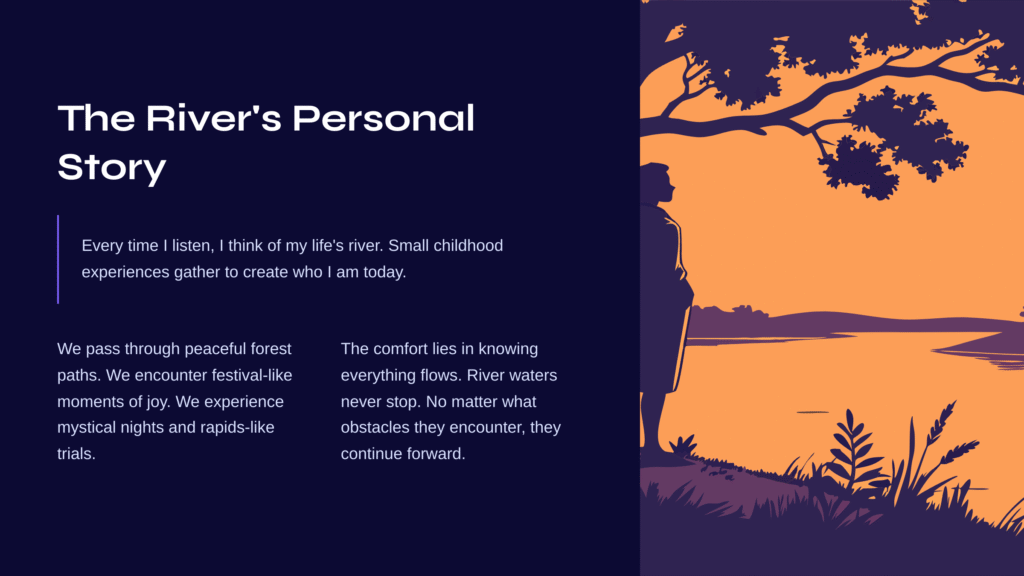
The River’s Personal Story
Every time I listen to this piece, I think of my life’s river. The process of small childhood experiences gathering to create who I am today resembles two springs meeting to become a great river. Sometimes we pass through peaceful forest paths, sometimes we encounter festival-like moments of joy. There are mystical quiet nights and times of rapids-like intense trials.
But above all, the comfort this music provides lies in the fact that everything flows. River waters never stop. No matter what obstacles they encounter, no matter what landscapes they pass, they continue flowing forward. And this music tells us that the flow itself is beautiful.
Especially in the final section, when all grandeur fades and only quiet strings remain, I always find myself contemplating life’s essential things. Splendid things all pass away, but the flow itself is eternal—this is the truth the music reveals.
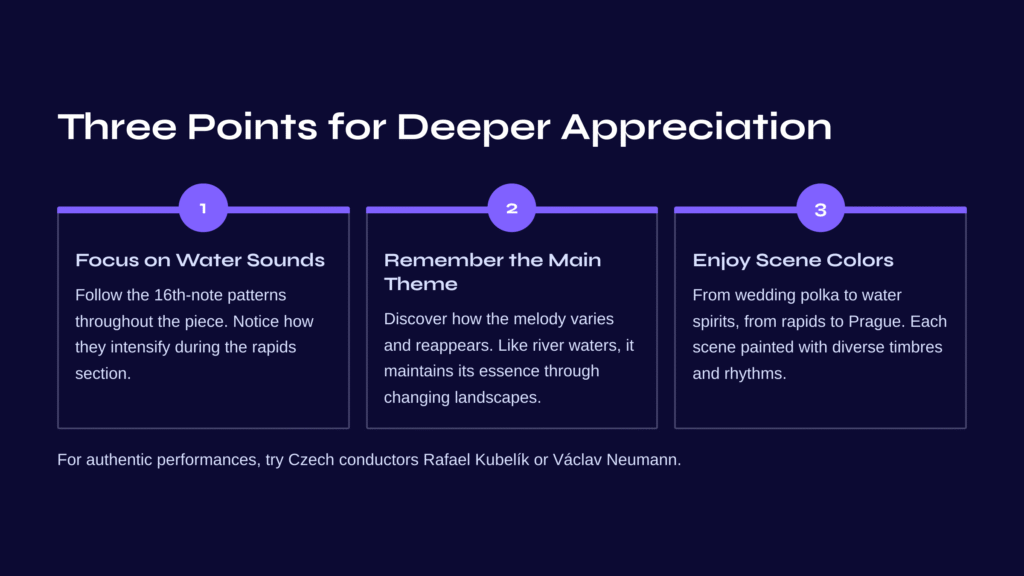
Three Points for Deeper Appreciation of Vltava
First, focus on the sounds of water. Follow the 16th-note patterns that run throughout the entire piece. Listening to how they change and develop will make you feel like you’re truly traveling with the river. Pay special attention to how these water rhythms become intense during the rapids section.
Second, remember Vltava’s main theme. There’s joy in discovering how this melody, first introduced by strings, is varied and reappears throughout the piece. Just as river waters never lose their essence regardless of what landscapes they pass, this melody continues to stay with us.
Third, enjoy the colors of each scene. From the wedding polka to the mystical dance of water spirits, from the rapids’ grandeur to Prague’s majesty. Smetana vividly painted each scene with truly diverse timbres and rhythms. Close your eyes while listening, and these scenes will truly unfold before you.
When choosing recordings, I recommend performances by Czech conductors. Particularly in performances by Rafael Kubelík or Václav Neumann, you can feel more deeply the Czech emotions embedded in this piece.
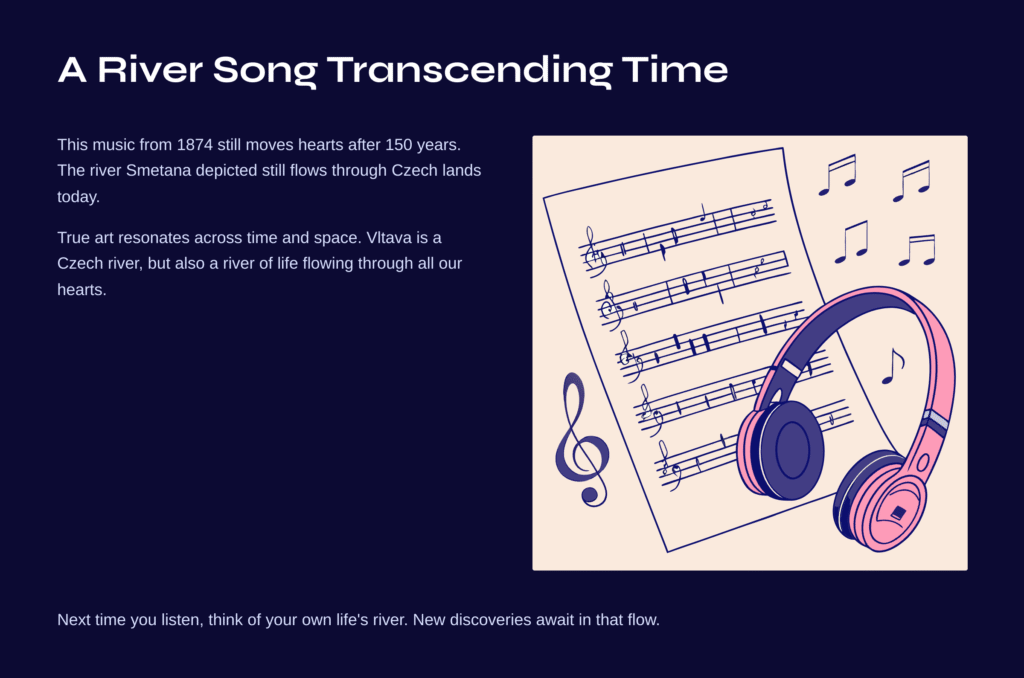
A River Song That Transcends Time
Listening to Vltava, I always contemplate the mystery of time. The fact that this music, born in 1874, still moves our hearts after 150 years is remarkable. The river Smetana depicted still flows through Czech lands today, and the river in this music continues to flow through our hearts, transcending time.
Perhaps this is what true art is—something born in a specific time and place, yet capable of resonating in everyone’s heart across time and space. Vltava is a Czech river, but simultaneously it’s a river of life flowing through all our hearts.
Next time you listen to this piece, don’t hear it merely as beautiful classical music. Listen while thinking of your own life’s river. The new discoveries you’ll encounter in that flow will make this music even more special.
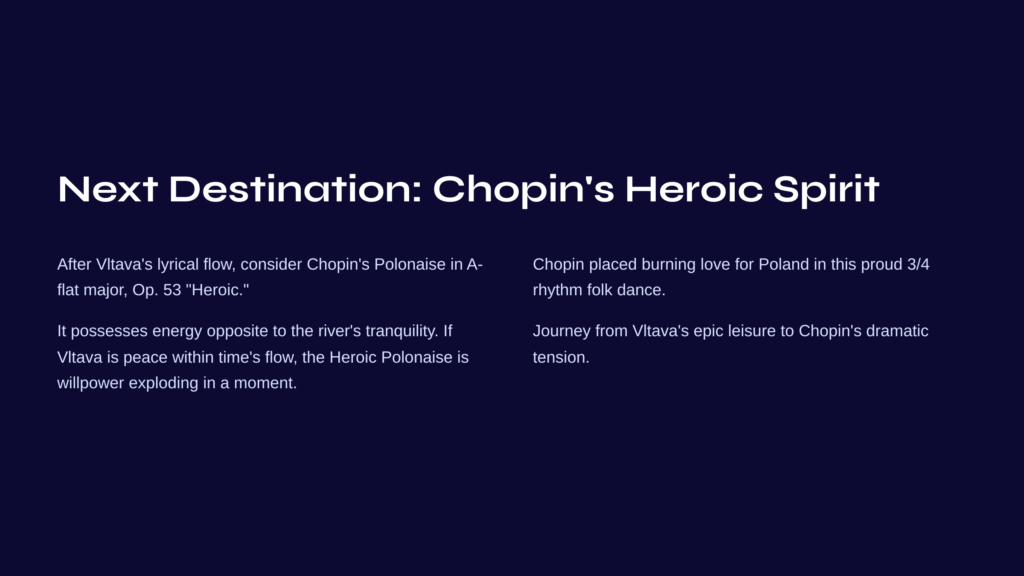
Next Destination: Chopin’s Heroic Spirit
What if, after being immersed in Vltava’s lyrical flow, you suddenly encountered the magnificent rhythm of a polonaise? Chopin’s Polonaise in A-flat major, Op. 53 “Heroic” possesses energy completely opposite to the river’s tranquility. If Vltava represents peace found within time’s flow, the Heroic Polonaise embodies willpower exploding in a single moment.
Upon the proud 3/4 rhythm of the polonaise, a Polish folk dance, Chopin placed burning love for his homeland and indomitable spirit. Composed in Parisian salons while longing for his homeland Poland, this piece embedded the national soul in a completely different way from Smetana’s river-longing approach. How about a journey from Vltava’s epic leisure to Chopin’s dramatic tension?
